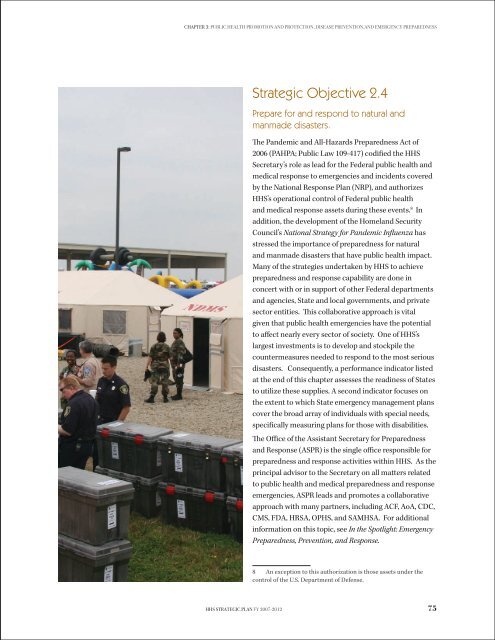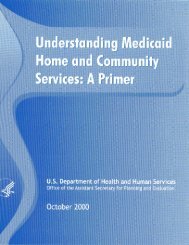CHAPTER 3: Public <strong>Health</strong> Promotion <strong>and</strong> Protection, Disease Prevention,<strong>and</strong> Emergency Preparedness<strong>and</strong> effectiveness <strong>of</strong> the program effort. SAMHSA willcontinue to utilize the SPF <strong>and</strong> exp<strong>and</strong> its use through itsState <strong>and</strong> local grant programs.Suicide PreventionFor every two victims <strong>of</strong> homicide in the United States,there are three Americans who take their own lives.Suicide is a potentially preventable public healthproblem. Studies <strong>of</strong> youth who have committed suicidehave found that 90 percent had a diagnosable mental<strong>and</strong>/or substance abuse disorder at the time <strong>of</strong> theirdeath. xxxi SAMHSA supports activities authorized by theGarrett Lee Smith Memorial Act <strong>of</strong> 2004 (Public Law 108-355), which support statewide youth suicide intervention<strong>and</strong> prevention strategies in schools, institutions <strong>of</strong>higher education, juvenile justice systems, substanceabuse <strong>and</strong> mental health programs, foster care systems,<strong>and</strong> other youth support organizations. Additionally,OD is working on an initiative to underst<strong>and</strong> <strong>and</strong> helpprevent suicide among persons with disabilities <strong>and</strong>those who incur disabilities.Risk ReductionChronic conditions currently limit activities for 12million older people living in community settings inthe United States; 25 percent <strong>of</strong> these individuals areunable to perform basic activities <strong>of</strong> daily living, suchas bathing, shopping, dressing, or eating. Furthermore,falls are the leading cause <strong>of</strong> injury-related deaths <strong>and</strong>hospital admission among older people <strong>and</strong> account forbetween 20 billion <strong>and</strong> 30 billion health care dollars inthe United States each year. These numbers will increasedramatically in the coming years with the aging <strong>of</strong> theBaby Boom Generation. AHRQ, AoA, CDC, CMS, <strong>and</strong>NIH contribute to research, demonstrations, the setting<strong>of</strong> national st<strong>and</strong>ards <strong>and</strong> guidelines, <strong>and</strong> the provision<strong>of</strong> grants <strong>and</strong> technical assistance to help older adultsmanage their chronic diseases <strong>and</strong> prevent falls <strong>and</strong> toencourage them to live healthy <strong>and</strong> active lifestyles.For example, AoA funds an Evidence-Based Disability<strong>and</strong> Disease Prevention grant program <strong>and</strong> public/private partnership which deploys proven disability<strong>and</strong> disease prevention programs at the communitylevel that empower older individuals to makebehavioral changes that will reduce their risk <strong>of</strong> disease,disability, <strong>and</strong> injury. AHRQ <strong>and</strong> AoA, in collaborationwith CDC, CMS, <strong>and</strong> NIH, are developing <strong>and</strong> testinga special Knowledge Transfer program targeted atState <strong>and</strong> local agency staff to promote <strong>and</strong> facilitatethe utilization <strong>of</strong> evidence-based disease preventionprograms for older people at the community level. CDCfunds fall prevention research, research dissemination,<strong>and</strong> research translation <strong>and</strong> implementation that helpdecrease falls <strong>and</strong> increase stability in mobile olderadults. CMS is demonstrating a health promotion <strong>and</strong>disease prevention program through the MedicareSenior Risk Reduction Demonstration to determinewhether health risk reduction programs that have beendeveloped, tested, <strong>and</strong> shown to be effective in theprivate sector can be tailored to the Medicare programto help beneficiaries improve their health <strong>and</strong> thusreduce the need for health care services.74 HHS Strategic Plan FY 2007-2012
CHAPTER 3: Public <strong>Health</strong> Promotion <strong>and</strong> Protection, Disease Prevention,<strong>and</strong> Emergency PreparednessStrategic Objective 2.4Prepare for <strong>and</strong> respond to natural <strong>and</strong>manmade disasters.The P<strong>and</strong>emic <strong>and</strong> All-Hazards Preparedness Act <strong>of</strong>2006 (PAHPA; Public Law 109-417) codified the HHSSecretary’s role as lead for the Federal public health <strong>and</strong>medical response to emergencies <strong>and</strong> incidents coveredby the National Response Plan (NRP), <strong>and</strong> authorizesHHS’s operational control <strong>of</strong> Federal public health<strong>and</strong> medical response assets during these events. 8 Inaddition, the development <strong>of</strong> the Homel<strong>and</strong> SecurityCouncil’s National Strategy for P<strong>and</strong>emic Influenza hasstressed the importance <strong>of</strong> preparedness for natural<strong>and</strong> manmade disasters that have public health impact.Many <strong>of</strong> the strategies undertaken by HHS to achievepreparedness <strong>and</strong> response capability are done inconcert with or in support <strong>of</strong> other Federal departments<strong>and</strong> agencies, State <strong>and</strong> local governments, <strong>and</strong> privatesector entities. This collaborative approach is vitalgiven that public health emergencies have the potentialto affect nearly every sector <strong>of</strong> society. One <strong>of</strong> HHS’slargest investments is to develop <strong>and</strong> stockpile thecountermeasures needed to respond to the most seriousdisasters. Consequently, a performance indicator listedat the end <strong>of</strong> this chapter assesses the readiness <strong>of</strong> Statesto utilize these supplies. A second indicator focuses onthe extent to which State emergency management planscover the broad array <strong>of</strong> individuals with special needs,specifically measuring plans for those with disabilities.The Office <strong>of</strong> the Assistant Secretary for Preparedness<strong>and</strong> Response (ASPR) is the single <strong>of</strong>fice responsible forpreparedness <strong>and</strong> response activities within HHS. As theprincipal advisor to the Secretary on all matters relatedto public health <strong>and</strong> medical preparedness <strong>and</strong> responseemergencies, ASPR leads <strong>and</strong> promotes a collaborativeapproach with many partners, including ACF, AoA, CDC,CMS, FDA, HRSA, OPHS, <strong>and</strong> SAMHSA. For additionalinformation on this topic, see In the Spotlight: EmergencyPreparedness, Prevention, <strong>and</strong> Response.8 An exception to this authorization is those assets under thecontrol <strong>of</strong> the U.S. <strong>Department</strong> <strong>of</strong> Defense.HHS Strategic Plan FY 2007-201275
















